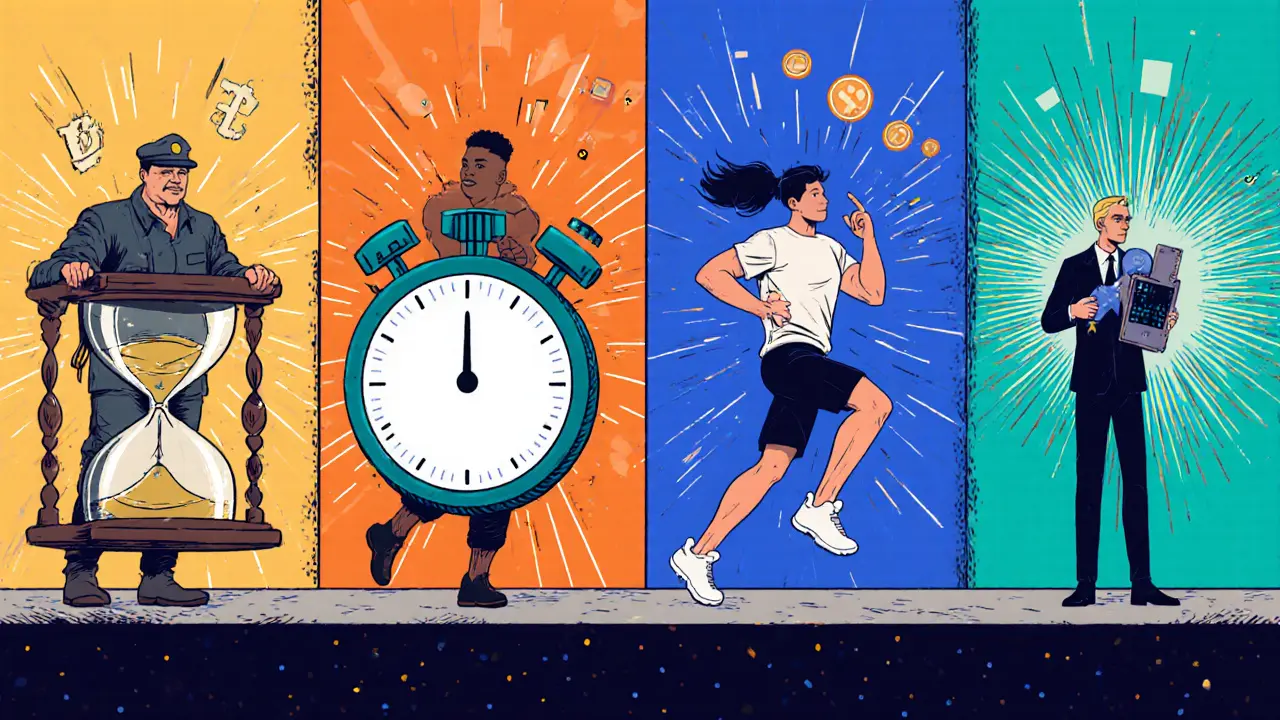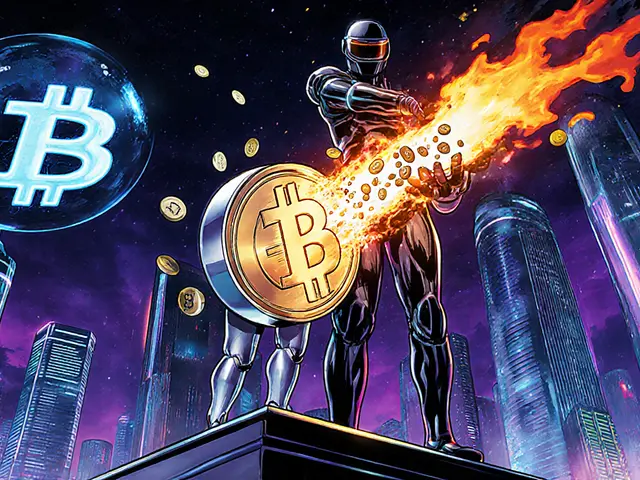Block Time & Transaction Speed Calculator
Calculated Results
0 transactions per second (TPS)
0 transactions per block
0 seconds per transaction
Bitcoin
10 min block time
1 MB block size
~7 TPS
Ethereum
12 sec block time
30 MB block size
15-30 TPS
Solana
0.4 sec block time
1 MB block size
~50,000 TPS
Cardano
20 sec block time
1 MB block size
~250 TPS
Understanding block time is key to grasping why some crypto payments feel slow. In a blockchain, the time it takes to seal a new block sets the pace for when a transaction is finally considered final.
Quick Takeaways
- Block time is the average interval between new blocks on a chain.
- Shorter block times increase throughput but can weaken security.
- Bitcoin’s 10‑minute block time limits it to ~7TPS, while faster chains reach thousands.
- Layer‑2 solutions (e.g., Lightning) bypass base‑layer limits without changing block time.
- Developers must design UI/UX around variable confirmation times.
What Is Block Time?
Block time is a measure of the average interval between successive blocks on a blockchain network. Every time miners solve the proof‑of‑work puzzle (or validators reach consensus in proof‑of‑stake), a new block is appended and the clock starts over. The target interval is baked into the protocol: Bitcoin aims for 10 minutes, Ethereum currently targets ~12 seconds, and Solana races at 400ms.
How Block Time Drives Transaction Speed
Transaction speed-often expressed as confirmations per second (CPS) or transactions per second (TPS)-is directly tied to two variables: block time and block size. A transaction is first broadcast to the network, then it waits in the mempool until a miner includes it in the next block. If the block time is long, the waiting period lengthens.
Consider Bitcoin: a 1‑MB block holds roughly 2,000 average‑size transactions. With a 10‑minute interval, the network can process about 7TPS (2,000tx ÷ 600s). Ethereum’s 12‑second block time and larger gas limit translate to roughly 15‑30TPS, while Solana’s sub‑second block time pushes the headline figure past 50kTPS. The math is straightforward: TPS ≈ (block size ÷ average tx size) ÷ block time. Reduce the block time, and you boost the denominator, raising TPS.
Security vs. Speed: The Core Trade‑Off
Mining difficulty is the algorithmic adjustment that keeps block time near its target despite fluctuations in hash power plays a starring role in the security‑speed balance. When block times shrink, the network has less time to propagate a new block to all nodes. Faster propagation reduces the chance of orphaned blocks but also raises the probability of temporary forks, which attackers could exploit.
Short block intervals demand more frequent communication between nodes, increasing bandwidth and computational requirements. This pressure can push smaller operators out of the validator set, nudging the network toward centralization-a direct hit to the decentralization goal. Bitcoin’s 10‑minute cadence, by contrast, allows ample time for block diffusion, making it extremely resistant to double‑spend attacks.

Real‑World Comparisons
| Chain | Block Time | Typical Block Size | Max TPS | Primary Security Model |
|---|---|---|---|---|
| Bitcoin | 10min | 1MB | ~7 | Proof‑of‑Work (high) |
| Ethereum | 12s | 30MB (post‑Shanghai) | 15‑30 | Proof‑of‑Work → Proof‑of‑Stake (medium) |
| Solana | 0.4s | ~1MB | ~50000 | Proof‑of‑History + PoS (low‑medium) |
| Cardano | 20s | ~1MB | ~250 | Proof‑of‑Stake (high) |
The table shows the clear correlation: lower block times enable higher TPS, but each chain also adopts different consensus tweaks to preserve security. Solana’s sub‑second blocks are possible because it pairs a novel proof‑of‑history clock with a smaller validator set, a design that sacrifices some decentralization for raw speed.
What This Means for Users and Developers
When you send a Bitcoin transaction, you’re essentially asking miners to tuck your data into the next 10‑minute window. If the mempool is congested, miners prioritize higher transaction fee the extra satoshis paid to incentivize faster block inclusion. During peak demand, fees can spike to dozens of dollars, and confirmation may take 30‑60 minutes for a “six‑confirmation” settlement.
Contrast that with a Lightning Network payment. Lightning moves the bulk of the transfer off‑chain, settling only the net result on Bitcoin’s base layer every few minutes. Users experience near‑instant confirmation while still benefiting from Bitcoin’s underlying security.
Developers building wallets or merchant tools should:
- Expose real‑time fee estimates so users can choose between speed and cost.
- Allow configurable confirmation thresholds (e.g., 1‑conf for small purchases, 6‑conf for large transfers).
- Provide fallback to Layer‑2 options when base‑layer latency would break the user flow.
Scaling Solutions That Bypass Block‑Time Limits
Lightning Network is a Layer‑2 protocol that creates payment channels between parties, enabling rapid micro‑transactions off the main chain is the most mature solution for Bitcoin. By aggregating thousands of tiny payments off‑chain, it reduces pressure on the 10‑minute block schedule.
Other chains adopt different approaches: Ethereum’s rollups (Optimistic, zk‑Rollup) batch many transactions into a single on‑chain record, effectively achieving “virtual” faster block times without altering the underlying consensus. Polkadot’s parachains act as sovereign lanes that process their own blocks while anchoring to a shared security relay chain.
The common theme is that developers don’t need to rewrite the base protocol’s block time; instead, they build complementary layers that inherit the security guarantees while delivering high‑speed user experiences.
Future Outlook
Research into adaptive block intervals is ongoing. Some proposals suggest dynamic block times that shrink during low‑load periods and expand when the network is busy, aiming to keep latency low without sacrificing safety. However, the broader community still favors preserving Bitcoin’s 10‑minute interval because it has proven resilient for over a decade.
For most practitioners, the practical path forward is to combine a solid understanding of block time mechanics with the strategic use of scaling solutions. That way, you get the best of both worlds: Bitcoin’s rock‑solid security and the near‑instant payments users expect from modern apps.
Frequently Asked Questions
Why does Bitcoin take about 10 minutes to confirm a transaction?
The protocol was designed to target a 10‑minute block interval. This gives the network enough time to propagate new blocks worldwide, keeping the chance of conflicting forks low and ensuring strong security.
Can I make Bitcoin transactions faster without paying high fees?
Yes - by using the Lightning Network or another Layer‑2 solution you can settle instantly while keeping fees tiny. On‑chain you’ll need to pay a higher fee to compete for inclusion in the next block.
How does block time affect transaction throughput?
Throughput (TPS) equals the number of transactions a block can hold divided by the block time. Shorter block times increase the denominator, allowing more transactions per second, assuming block size stays constant.
Are faster block times always better?
Not necessarily. Faster intervals reduce confirmation latency but can increase fork rates, demand higher bandwidth, and push out smaller validators, which may hurt decentralization and security.
What role does mining difficulty play in keeping block time stable?
Difficulty adjusts automatically (e.g., every 2,016 blocks in Bitcoin) to ensure the average block time stays near its target, regardless of how many miners join or leave the network.




vincent gaytano
May 12 2025Oh sure, the block time is just another hidden lever the shadowy architects pull to keep us all chained to their cryptic timelines. They whisper that a ten‑minute interval is “secure,” but really it’s a sweet spot for them to monetize every impatient soul. If you think decentralization is free, you’re buying the illusion they sell on late‑night forums. The real agenda? Keep the network slow enough that only the well‑funded can afford the “instant” shortcuts. In the grand scheme, every second you wait is a tribute to the unseen elite.
Dyeshanae Navarro
May 20 2025From a philosophical angle, the cadence of a blockchain mirrors the rhythm of patience in our daily lives. When we accept slower confirmations, we learn to value security over instant gratification. Simple awareness of this trade‑off can actually empower users to make more informed choices. By embracing the inherent delay, we align ourselves with the system’s design rather than fighting it.
Matt Potter
May 27 2025Come on, folks, don’t let the numbers scare you-block time is just a speed limit, not a dead end! Faster chains are proving that we can have both security and lightning‑quick transactions if we push the tech forward. Every new protocol that shaves milliseconds off the block interval is a win for the whole ecosystem. Let’s celebrate the progress and keep the momentum rolling, because the future is undeniably faster.
Marli Ramos
June 3 2025Meh, looks like another tech rant 😂
Christina Lombardi-Somaschini
June 10 2025Indeed, the evolution of block intervals represents a fascinating blend of engineering ambition and economic necessity; however, it is essential to recognize that each reduction in block time introduces a proportional increase in network communication overhead, which can inadvertently marginalize smaller validators. Consequently, while celebrating rapid advancements, we must also critically assess the potential centralization pressures that arise. Balancing these forces ensures a resilient and inclusive blockchain environment.
katie sears
June 17 2025If we examine the cultural implications of these technical shifts, it becomes evident that diverse communities may experience disparate impacts; therefore, I would inquire how upcoming governance models intend to mitigate such inequities. Moreover, a thorough analysis of cross‑regional validator participation could illuminate pathways toward a more globally representative consensus.
Gaurav Joshi
June 25 2025One must confront the moral paradox: sacrificing decentralization for speed may compromise the very ethos that blockchain promises. The allure of instantaneous transactions should not blind us to the ethical cost of concentrating power in fewer hands. Prudence demands a measured approach that honors both efficiency and the foundational principle of trustlessness.
Kathryn Moore
July 2 2025Bitcoin ~7TPS, Ethereum 15‑30TPS, Solana ~50000TPS.
Christine Wray
July 9 2025While those figures illustrate the stark differences, it’s also important to contextualize them within each network’s security model and intended use cases. A high TPS on Solana comes with trade‑offs in validator diversity, whereas Bitcoin’s modest throughput underscores its robust proof‑of‑work resilience. Both approaches have merit depending on the application.
roshan nair
July 16 2025Understanding block time is akin to deciphering the pulse of a living organism, where each beat dictates the flow of its lifeblood. In proof‑of‑work ecosystems, miners, like diligent beavers, gnaw away at cryptographic puzzles, and the rhythm they set determines how swiftly new blocks are forged. When the interval is elongated, as in Bitcoin’s ten‑minute cadence, the network enjoys a generous window for block propagation, bolstering its defenses against double‑spend attacks. Conversely, shorten‑ing the interval, as witnessed in Ethereum’s twelve‑second stride, accelerates transaction finality but demands a more robust communication fabric among nodes. Solana pushes this concept to the extreme, slicing block time down to a mere four‑tenths of a second, which is reminiscent of a hummingbird’s heartbeat, delivering astonishing throughput at the expense of a narrower validator pool. The mathematics behind throughput is elegantly simple: TPS roughly equals the block size divided by the average transaction size, all over the block time, yet the real‑world implications are far more nuanced. A faster block time inevitably raises the probability of temporary forks, compelling validators to reconcile discrepancies more frequently, which can strain network resources. Moreover, the bandwidth consumption surges, potentially sidelining participants with limited connectivity, thereby nudging the system toward centralization. From a developer’s perspective, designing user experiences around these dynamics requires a delicate balance between responsiveness and reliability. Wallets, for instance, must convey realistic confirmation estimates, allowing users to decide whether to wait for additional blocks or accept a higher fee for expedited inclusion. Layer‑2 solutions, such as the Lightning Network, cleverly sidestep the base‑layer latency by aggregating myriad micro‑transactions off‑chain, settling only the net result periodically, a strategy that preserves Bitcoin’s security while delivering near‑instantaneous user experiences. Rollups on Ethereum adopt a similar philosophy by bundling transactions into succinct proofs, effectively creating a “virtual” faster block time without altering the underlying consensus. As the ecosystem matures, we may witness adaptive block intervals that dynamically adjust to network load, a concept reminiscent of traffic lights that modulate their cycles based on congestion. However, any such innovation must be meticulously vetted to ensure it does not erode the cryptographic guarantees that form the bedrock of trust. In summary, block time serves as both a lever of performance and a safeguard of security, and mastering its intricacies is essential for anyone aspiring to build resilient, high‑throughput blockchain applications.
Jay K
July 23 2025I appreciate the thorough exposition; it clarifies how diverse design choices shape user expectations. Your insight into adaptive intervals is especially thought‑provoking, and I concur that any shift must preserve core security guarantees.
Kimberly M
July 30 2025Exactly! The balance you highlighted is the cornerstone of sustainable growth 😊👍 Let’s keep sharing such nuanced perspectives.
Navneet kaur
August 7 2025Look, if you keep chasing speed you’re just feeding a selfish agenda, not caring about the real people who need secure money.